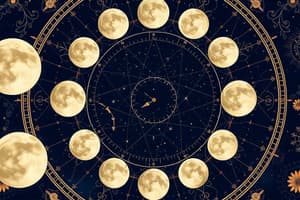Podcast
Questions and Answers
What is the primary reason for day and night on Earth?
What is the primary reason for day and night on Earth?
- The Sun's gravitational attraction
- The Earth's revolution around the Sun
- The Earth's rotation on its axis (correct)
- The Moon's orbit around the Earth
How does the Moon move in relation to the Earth?
How does the Moon move in relation to the Earth?
- The Moon is stationary in space
- The Moon rotates on its axis
- The Moon orbits the Earth as a satellite (correct)
- The Moon revolves around the Sun
During which celestial event does the Sun rise exactly in the east and set exactly in the west?
During which celestial event does the Sun rise exactly in the east and set exactly in the west?
- New Moon phase
- Winter solstice
- Summer solstice
- Equinoxes (correct)
What causes the repeating pattern of seasons on Earth?
What causes the repeating pattern of seasons on Earth?
What phenomenon causes the Sun to appear to move from East to West daily?
What phenomenon causes the Sun to appear to move from East to West daily?
In which direction does the Sun rise during winter in the northern hemisphere?
In which direction does the Sun rise during winter in the northern hemisphere?
What causes the Moon to appear to have a daily trip across the sky from east to west?
What causes the Moon to appear to have a daily trip across the sky from east to west?
During which phase of the Moon is it located on the opposite side of the Earth from the Sun?
During which phase of the Moon is it located on the opposite side of the Earth from the Sun?
What is the average orbital speed formula for the Moon as it orbits around the Earth?
What is the average orbital speed formula for the Moon as it orbits around the Earth?
Why is the new moon not visible from the Earth?
Why is the new moon not visible from the Earth?
What causes the Earth to experience different phases of the Moon?
What causes the Earth to experience different phases of the Moon?
How does the Sun's gravitational force affect the Moon's orbit around the Earth?
How does the Sun's gravitational force affect the Moon's orbit around the Earth?
At which points of the Earth's orbit are night and day equal in both hemispheres?
At which points of the Earth's orbit are night and day equal in both hemispheres?
Why do we never see the 'dark side of the Moon' from Earth?
Why do we never see the 'dark side of the Moon' from Earth?
During which event do we experience the longest day in the northern hemisphere and the shortest day in the southern hemisphere?
During which event do we experience the longest day in the northern hemisphere and the shortest day in the southern hemisphere?
What is the average distance between the Moon and Earth?
What is the average distance between the Moon and Earth?
What phenomenon causes the Moon's appearance to change over the course of each month?
What phenomenon causes the Moon's appearance to change over the course of each month?
Flashcards are hidden until you start studying
Study Notes
Phases of the Moon
- The moon appears as a complete circle during a full moon, when it is on the opposite side of the Earth from the Sun.
- A thin new crescent appears along one edge of the moon as it travels in its orbit and gradually increases in size.
- The last quarter phase occurs when the moon wanes.
Moon's Orbit
- The moon orbits the Earth in approximately a circular orbit once a month at an average distance away of about 400 000 km.
- The moon's orbital speed (v) is calculated by the formula: v = circumference of orbit / T, where T is the orbital period.
- The moon always has the same area of its surface facing towards the Earth, known as the 'near side'.
Sun, Earth, and Moon
- The sizes of the Earth, Sun, and Moon are compared: the Sun is about 110 times bigger than the Earth, and the Moon is about ¼ the size of the Earth.
- The Earth orbits the Sun in a nearly circular orbit, taking one year to complete.
- The Moon orbits the Earth as a satellite, with no atmosphere, but with a gravitational field due to its mass.
Earth's Rotation and Revolution
- The Earth's rotation on its axis causes day and night, with the Sun appearing to rise in the east and set in the west.
- The Earth takes one year to travel around the Sun, moving closer and further away with the seasons, controlled by the large gravitational attraction exerted by the Sun.
- The Earth's rotation causes the Sun to have an apparent daily journey from east to west, with exact rising and setting points at the equinoxes (around 20 March and 23 September).
Studying That Suits You
Use AI to generate personalized quizzes and flashcards to suit your learning preferences.




